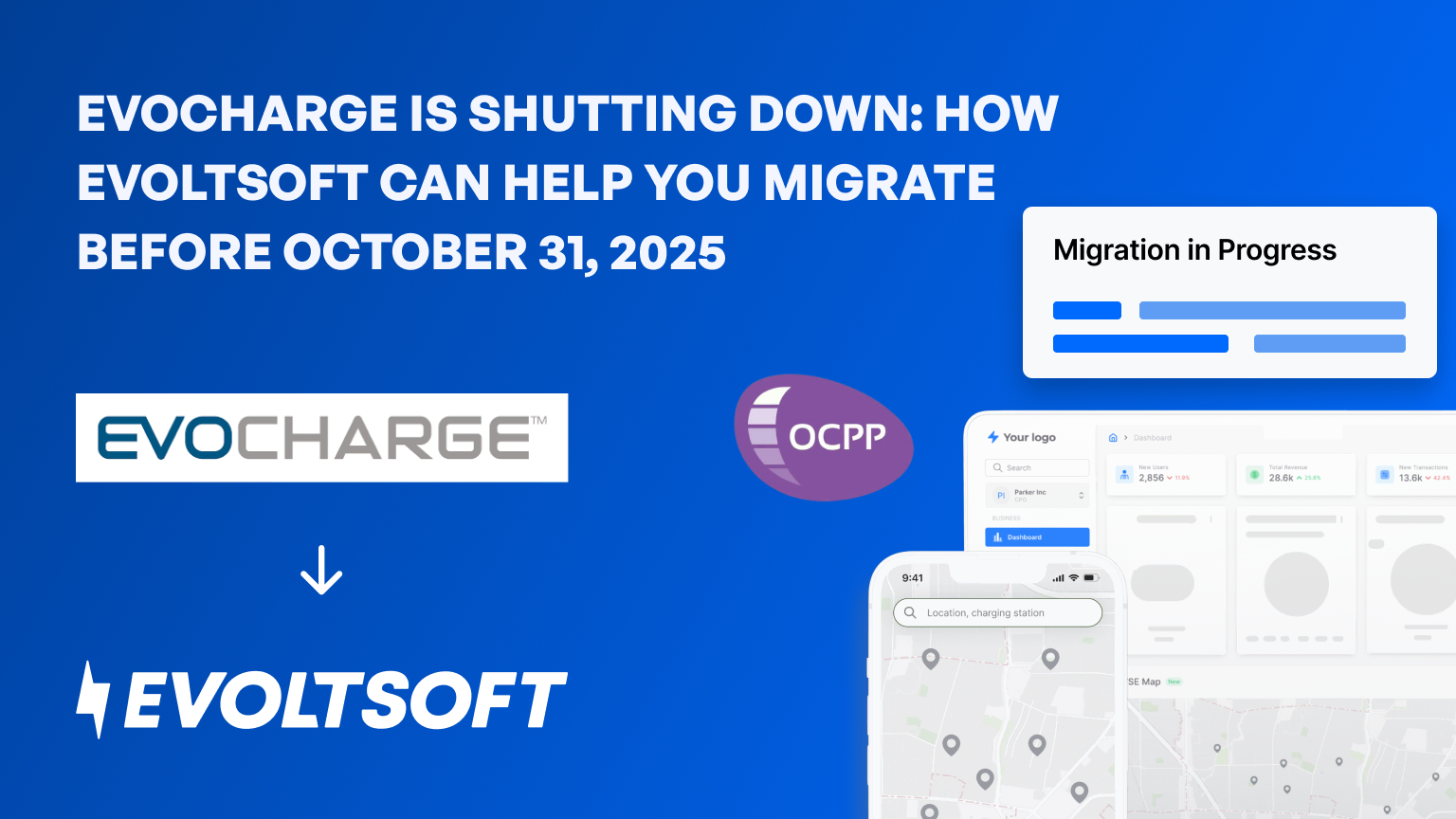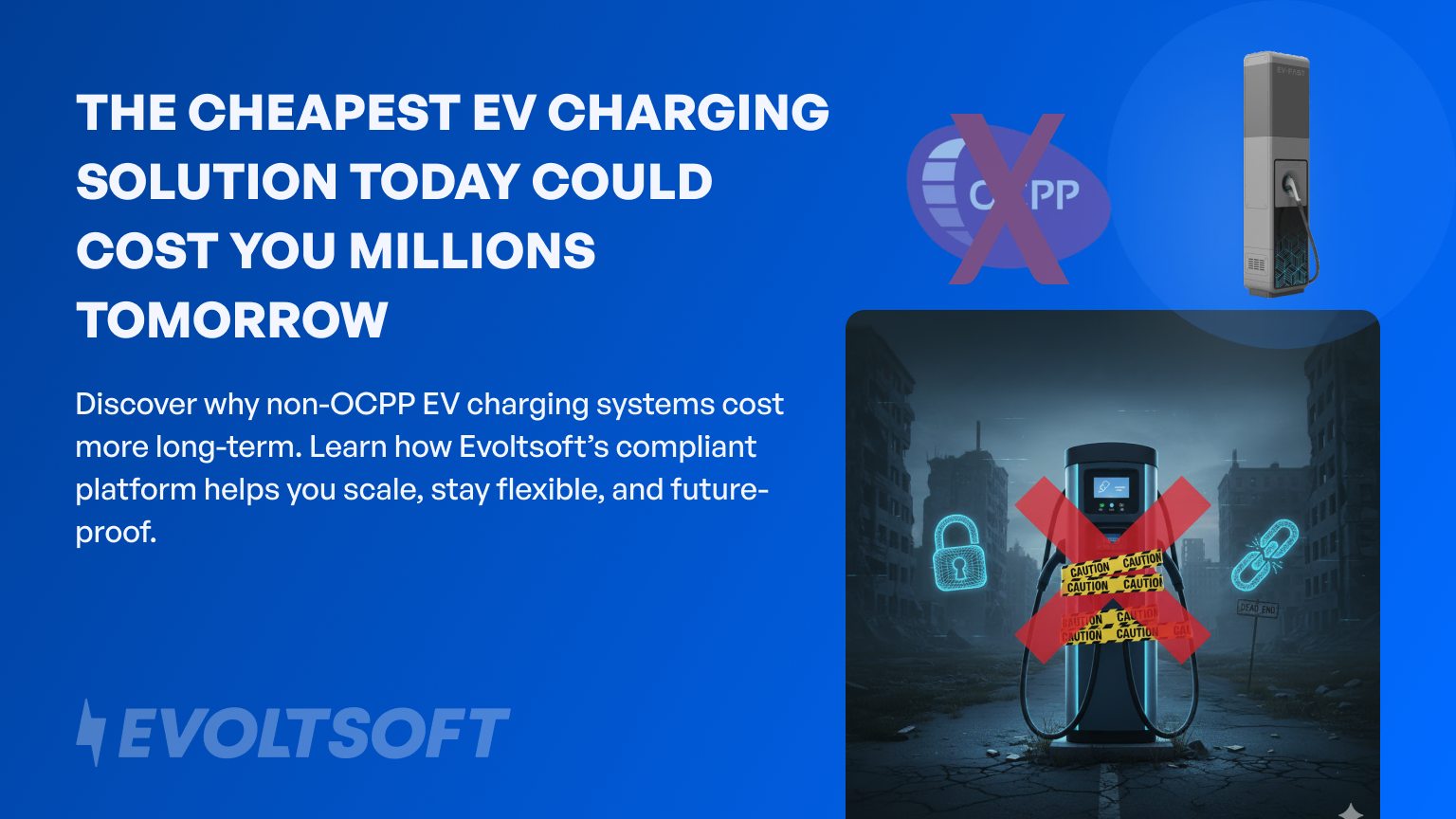Demand Response for EV Charging: Evoltsoft's OCPP Solutions
Welcome to a new era of electric vehicle charging, where demand response meets the cutting-edge capabilities of OCPP backends.

The Rise of Electric Cars: A New Era of Electricity Consumption
The advent of electric vehicles (EVs) has brought about a monumental shift in electricity consumption, rivaling the impact of air conditioning units when they were first introduced.
However, with the rapid proliferation of electric vehicles, we now face a pressing challenge: the strain on our electric grid and surging peak power demands.
While the electric grid has long grappled with issues of grid strain and peak power demand, the current focus on renewable energy sources, which inherently offer intermittent power generation, demands a fresh perspective on how to tackle peak demand.
Consider this scenario: Utilities facing surges in demand on scorching summer days employ a tactic known as 'demand response' to balance the delicate equilibrium of electricity supply and demand. This approach becomes necessary because, in most cases, altering the supply of electricity production from power plants is a complex and time-consuming process.
In this article, we delve into the realm of demand response, exploring how both consumers and utilities actively respond to signals aiming to curtail their electricity consumption during specific periods of heightened demand.
Unlocking Demand Response: A Smart Solution for Electricity Management
Demand response is a sophisticated technology-driven approach that serves as an economic rationing system for electric power supply. In simpler terms, it's a strategic tool that allows us to optimize electricity consumption while maintaining reliability.
According to the International Energy Agency (IEA), demand response has the potential to shift up to 15% of annual electricity demand by 2050, making it a powerful instrument for managing our energy needs.
Demand response encompasses a wide array of measures designed to reduce electricity demand, especially during peak periods, thus preventing system overloads and potential outages. It's a collaborative effort involving both utility companies and consumers, whether they are in the commercial or private sector.
Here's how it works:
Utility companies leverage smart meters and smart grid technology to enhance consumption monitoring and identify peak demand periods.
Consumers play a vital role by adjusting their electricity usage during peak demand times—simple actions like turning off lights, air conditioning, and non-essential electrical appliances and machinery can make a significant difference.
Demand response offers a cost-effective alternative to building more generation capacity to address occasional demand spikes. The IEA advocates for the adoption of new business models and the implementation of standards for equipment and appliance controllability, all aimed at reducing demand and promoting efficient energy management.
Integrating Demand Response with Electric Vehicles: Enhancing Grid Management
The surge in electric vehicle adoption, which surpasses the electricity consumption of all other household appliances combined, and the expansion of renewable energy sources with intermittent power generation, present new complexities in grid management.
These challenges manifest when unexpected weather fluctuations affect the output of solar panels and wind turbines. In such scenarios, demand response emerges as a crucial tool for controlling vehicle charging and restoring equilibrium to the grid.
While charging electric cars can strain the grid, when executed strategically, it can become an invaluable asset for enhancing grid reliability, especially when coupled with OCPP.
OCPP, or the Open Charge Point Protocol, serves as an IoT (Internet of Things) protocol that facilitates bilateral communication between EV chargers and software backend systems. Remarkably, 60-70% of public charging stations employ OCPP to enable various functionalities, such as payment systems, user access control, and charger monitoring. What's even more noteworthy is that OCPP provides these charging stations with the capability to implement demand response strategies.
To set demand response into action, the charging point operator taps into the OCPP protocol's smart charging module. This module empowers the central software backend to transmit charging commands, referred to as charging profiles, to the charging stations. These commands can include throttling charging during peak demand periods or ramping up vehicle charging when there's an abundant supply of wind or solar power.
Empowering Electric Fleets with Demand Response
The batteries within electric vehicles (EVs) hold untapped potential as a vital resource for grid balance. In today's landscape, numerous utility programs are paving the way, offering enticing incentives that encompass covering the installation costs of EV charging and stipulating 'demand response readiness.'
Nonetheless, it's essential to recognize that demand response doesn't exclusively benefit utilities. Owners of substantial charging sites, such as airports, extensive employee parking facilities, and fleet depots, stand to gain significantly from adopting demand response strategies.
When a charging station owner becomes part of a demand response program, they open the door to additional revenue streams. By allowing the utility to make minor adjustments to their charging behavior a few times a year, the owner receives compensation in return.
This presents a particularly attractive opportunity for large fleet depots housing hundreds of vehicles. Here at Evoltsoft, we've devised multiple approaches that seamlessly integrate demand response, all without compromising on-time departures or any other adverse effects on daily business operations.
What Happens in a Demand Response Event?
During a demand response event, the utility communicates essential information about the changes to be implemented and the associated schedule, specifying start and stop times. This communication channel is crucial for coordinating the response of charging points.
There are various methods for the utility or utility service provider to transmit a demand response event to a charging point operator. In a typical scenario, the changes introduced in such an event encompass one or more of the following aspects:
- PRICE_ABSOLUTE: This indicates changes in the price per kilowatt-hour (kWh).
- PRICE_RELATIVE: This reflects a shift in the price per kilowatt-hour relative to the current rate.
- PRICE_MULTIPLE: It involves applying a multiple of the standard rate per kilowatt-hour.
- LOAD_AMOUNT: Specifies a fixed load value to be either reduced or shifted.
- LOAD_PERCENTAGE: This expresses the percentage of load to be shed or shifted.
This means that the utility has the flexibility to transmit either a price-related signal or a load-related signal. Load signals are generally measured in Kilowatts (kW), while price signals are typically denominated in currencies like USD/kWh or EUR/kWh.
For instance, consider a scenario where the charging point operator receives a load amount directive, indicating a specific load value (in kW) that needs to be reduced or shifted. The smart charging software then takes this information into account, alongside other operational objectives, such as ensuring on-time departures.
This allocated load amount can be distributed among the chargers at a location, with each charger receiving a smart charging profile via the Open Charge Point Protocol (OCPP).


In Conclusion: Pioneering a Sustainable Energy Future
The dawn of smart grids has ushered in an era of remarkable potential for enhancing demand response. With the advent of real-time data and the proliferation of IoT-connected devices, our capacity to respond effectively and swiftly to dynamic events has never been more promising.
Notably, electric vehicles (EVs) have emerged as a vital asset in the realm of demand response. The seamless integration of plug-in electric vehicles (PEVs) with smart grids has proven instrumental in advancing our pursuit of sustainable energy systems.
Picture a parking lot adorned with EVs, an ensemble of aggregated energy poised to address the challenges of peak demand. Within this landscape, a charging point operator leverages the power of OCPP to orchestrate intelligent charging, efficiently managing the charging speeds of EVs in response to demand fluctuations.
Here, the exceptional capabilities of software like Evoltsoft come into play, where OCPP-enabled smart charging shines as a beacon of efficiency for both electric vehicle owners and fleet operators. Simultaneously, it empowers utility service providers to exercise precision in grid management.
In this landscape, we stand on the precipice of a more sustainable, resilient, and responsive energy future. Through the seamless synergy of smart grids, electric vehicles, and advanced software solutions, we are paving the way for a greener tomorrow—a future where demand response is not merely a concept but a living reality.



